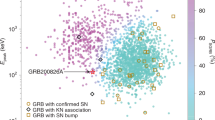Abstract
THE nature and evolution of binary X-ray sources in globular clusters are poorly understood. Among the ∼10 bright X-ray sources in globular clusters, X2127+11 in M15 is very important because it is the only one for which the optical counterpart, AC211, and orbital period, 8.5 h, are both known1. We have detected a type I X-ray burst from X2127+11, which was the only bright X-ray source in a globular cluster from which no burst had been detected. The burst was of long duration (≳150s) and had a precursor separated from the main peak by ∼6 s. This means that the burst was very energetic and that a large photospheric expansion occurred. The observed burst peak luminosity, well above 1038 erg s−1, is hard to reconcile with the standard idea that X2127+11 is screened from direct view by an accretion disk. This latter view arises from consideration of the low ratio of X-ray to optical luminosity, which suggests that only a small fraction of X-rays is visible through scattering by an accretion-disk corona around the source2–4.
This is a preview of subscription content, access via your institution
Access options
Subscribe to this journal
Receive 51 print issues and online access
$199.00 per year
only $3.90 per issue
Buy this article
- Purchase on Springer Link
- Instant access to full article PDF
Prices may be subject to local taxes which are calculated during checkout
Similar content being viewed by others
References
Charles, P. A. & Naylor, T. Adv. Space Res. 8, 515–523 (1988).
Charles, P. A., Jones, D. C. & Naylor, T. Nature 323, 417–419 (1986).
Naylor, T., Charles, P. A., Drew, J. E. & Hassall, B. J. M. Non. Not. R. astr. Soc. 233, 285–304 (1988).
Bailyn, C. D., Garcia, M. R. & Grindlay, J. E. Astrophys. J. 344, 786–790 (1989).
Turner, M. J. L. et al. Publs astr. Soc. Japan 41, 345–372 (1989).
Makino, F. et al. Astr. Lett. Commun. 25, 223–233 (1987).
Callanan, P. J., Naylor, T. & Charles, P. A. in Accretion-Powered Compact Binaries (ed. Mauche, C. W.) (Cambridge University Press, in the press).
Hoffman, J. A., Marshall, H. L. & Lewin, W. H. G. Nature 271, 630–633 (1978).
Lewin, W. H. G. & Joss, P. C. Space Sci. Rev. 28, 3–88 (1981).
Hoffman, J. A. et al. Astrophys. J. 221, L57–L62 (1978).
Tawara, Y. et al. Astrophys. J. 276, L41–L44 (1984).
Lewin, W. H. G., Vacca, W. D. & Basinska, E. M. Astrophys. J. 277, L57–L60 (1984).
Tawara, Y., Hayakawa, S. & Kii, T. Publs astr. Soc. Japan 36, 845–853 (1984).
Murakami, T., Inoue, H., Makishima, K. & Hoshi, R. Publs astr. Soc. Japan 39, 879–886 (1987).
Shibazaki, N. & Ebisuzaki, T. Publs astr. Soc. Japan 41, 641–650 (1989).
Mason, K. O. in The Physics of Accretion onto Compact objects (eds Mason, K. O., Watson, M. G. & N. E. White) 29–57 (Springer-Verlag, New York, 1986).
Fahlmann, G. G., Richer, H. B. & VandenBerg, D. A. Astrophys. J. Suppl. Ser. 58, 225–254 (1985).
Van Paradijs, J., Dotani, T., Tanaka, Y. & Tsuru, T. Publs astr. Soc. Japan (in the press).
Auriere, M., Maucherat, A., Cordoni, J-P., Fort, B. & Picat, J. P. Astr. Astrophys. 158, 158–160 (1986).
Ilovaisky, S. A. et al. Astrophys. J. 179, L1–L4 (1987).
White, N. E. & Holt, S. S. Astrophys. J. 257, 318–337 (1982).
Van Paradijs, J., Penninx, W. & Lewin, W. H. G. Mon. Not. R. astr. Soc. 233, 437–450 (1988).
Mitsuda, K., Inoue, H., Nakamura, N. & Tanaka, Y. Publs astr. Soc. Japan 41, 97–111 (1989).
Callanan, P. J., Fabian, A. C., Tennant, A. F., Redfern, R. M. & Shafer, R. A. Mon. not. R. astr. Soc. 224, 781–789 (1987).
Fabian, A. C., Guilbert, P. W. & Callanan, P. J. Mon. Not. R. astr. Soc. 225, 29P–31P (1987).
Author information
Authors and Affiliations
Rights and permissions
About this article
Cite this article
Dotani, T., Inoue, H., Murakami, T. et al. Discovery of an X-ray burst from X2127+11 in the globular cluster M15. Nature 347, 534–536 (1990). https://doi.org/10.1038/347534a0
Received:
Accepted:
Published:
Issue Date:
DOI: https://doi.org/10.1038/347534a0
This article is cited by
-
X-ray burster is theory buster
Nature (1990)
Comments
By submitting a comment you agree to abide by our Terms and Community Guidelines. If you find something abusive or that does not comply with our terms or guidelines please flag it as inappropriate.



